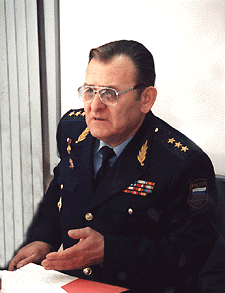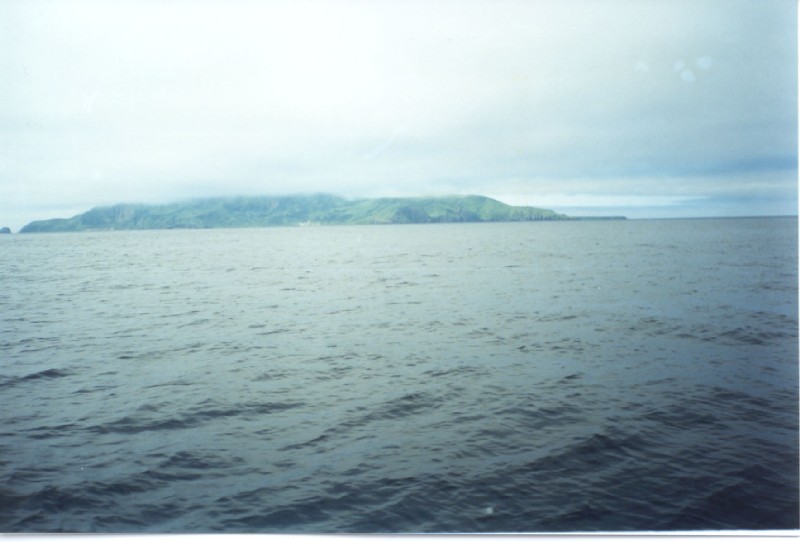|














| |
Escape from Destruction
Cast of Characters
Kornukov—General Anatoli Kornukov, Commander Sokol Air Force Base
(Sakhalin). Kornukov was appointed Russia’s new Air Force
Commander by Boris Yeltsin on January 22, 1998. He served in this
capacity until
retiring in January 2002.
Gerasimenko—Lt. Colonel, Acting Commander, 41st Fighter Regiment
Novoseletski—Lt. Colonel, Acting Chief of Staff, Fighter Division,
Smirnykh Air Force Base
Osipovich—Maj. Gennadie Osipovich, pilot of Sukhoi 15 Flagon
(SU-15) interceptor, call sign 805, based at Sokol on Sakhalin
Titovnin—Flight controller, Fighter Division Combat Control Center
Times are given in Coordinated Universal Time (UTC, formerly Greenwich
Mean Time or GMT). In the air over Sakhalin, it was early in the
morning of September 1, 1983.
The following is quoted from Rescue 007, pages 58
to 65 (with minor corrections). The Russian transcripts are from the
1993 ICAO report. Commentary is provided by Bert Schlossberg.
Major Osipovich, returning to Sokol Air Base on Sakhalin, believed his
mission accomplished. But quite a different conclusion was being
drawn by several Soviet radar command posts. For within
seconds—and for minutes after—after Osipovich had given his report, KAL
007 could clearly be seen still flying rather than disappearing from the
screen, as would have been the case if there had been a midair
explosion. Furthermore, according to the Digital Flight Data
Recorder tape, the jumbo jet was actually climbing.
 Kornukov: (18:26) Kornukov: (18:26)
Do you see the target on the screen?
Gerasimenko:
We can see [it] for the moment.
Kornukov:
Did he fire both missiles or one?
Gerasimenko:
Both missiles…
Kornukov:
Bring in the MiG 23.
Kornukov:
Gerasimenko!
Gerasimenko:
Yes.
Kornukov: (18:27)
This is the task… Bring the MiG 23 in to destroy the target.
Gerasimenko:
Yes, Sir.
Kornukov:
Gerasimenko.
Gerasimenko:
163 [designation for MiG 23] has been ordered to engage
afterburner. We are bringing him to attack position.
Kornukov:
Roger. Did Osipovich see the missiles explode? Hello?
Gerasimenko:
He fired two missiles.
Kornukov:
Ask him, ask him yourself, get on channel 3 and ask Osipovich, did he or
did he not see the explosions?
Gerasimenko:
Right away.
According to United States electronic intelligence intercepts, Osipovich
was asked at 18:27, “805, did you launch one missile or both?”
Osipovich replied, “I launched both.” But within two minutes of
impact, concern about the airliner’s survival had spread to other
command posts. At 18:28, when, according to the Soviet and
Japanese radar sightings and the Digital Flight Data Recorder, KAL 007
was about to begin its five minute accelerated descent to attain normal
breathing altitude, Lt. Col. Novoseletski, the Commander of Smirnykh Air
Base, expresses that concern to Titovnin, Maj. Osipovich’s ground
controller.
Novoseletski: (18:28)
Titovnin, well, what is happening?
Titovnin:
Nothing for the moment.
Novoseletski:
Well, what is happening, what is the matter, who guided him in, he
locked on, why didn’t he shoot it down?
Titovnin:
They fired. They fired. We are now waiting for the result,
Comrade Colonel.
At 18:28, General Kornukov has been made aware not only of KAL 007’s
survival, but also of its maneuverability.
Gerasimenko:
The target turned to the north.
Kornukov:
The target turned to the north?
Gerasimenko:
Affirmative.
Kornukov:
Bring the 23 [MiG] in to destroy it!
By 18:29, General Kornukov is furious over the failure to down KAL 007,
and he lashes out at Lt. Col. Gerasimenko. His speech and his
thoughts have become confused.
Gerasimenko:
Comrade right turn.
Kornukov:
Well, I understand, I do not understand the result, why is the target
flying? Missiles were fired. Why is the target flying?
[obscenities] Well, what is happening?
Gerasimenko:
Yes.
Kornukov:
Well, I am asking, give the order to the Controller, what is wrong with
you there? Have you lost your tongues?
Gerasimenko:
Comrade General, I gave the order to the Chief of Staff, the Chief of
Staff to the Controller, and the Controller is giving the order to…
Kornukov: (18:30)
Well, how long does it take for this information to get through, well,
what, [you] cannot ask the results of firing the missiles, where,
what, did [he] not understand or what?
The transcripts indicate that from 18:30 to 18:34 there is mounting
concern at the failure to down KAL 007. But, beginning at 18:34,
another concern begins to dominate at the various command posts—KAL 007
has disappeared from the radar scopes! Neither do the interceptors
have visual or radar contact with the jumbo jet. That this was not
caused by any midair mishap in the flight of KAL 007 is clear from
Soviet radar trackings other than those reported in the annexed
telecommunications—trackings that record KAL 007’s flight as lasting at
least until 18:38. It is these other trackings which were the
basis of United States State Department and United Nations assertions
that KAL 007 was in the air for at least 12 minutes after it had been
rocketed. Kornukov (18:32):
Tell 23 [MiG 23]...Afterburner. Open fire. Destroy the target, then land at home
base.
Gerasimenko:
Roger.
Kornukov:
Altitude...what is altitude of our fighter and the altitude of the target?
Quickly. the altitude of the target and the altitude of the fighter?...
Why don't you say anything?...Gerasimenko!...
Gerasimenko (18:33):
Gerasimenko. Altitude is 5,000.
Kornukov:
5,000 already?
Gerasimenko (18:34):
Affirmative, turning left, right, apparently it is descending.
At 18:34, then, eight minutes after missile impact, “attack” radar has
lost contact with Flight 007, never again to regain it. KAL 007 is
at this time at 16,400 feet altitude (5,000 meters).
Kornukov:
Destroy it, use the 23 to destroy it, I said!
Gerasimenko:
Roger, destroy it.
Kornukov:
Well, where is the fighter, how far from the target?
Gerasimenko:
Comrade General, they cannot see the target.
Kornukov:
They cannot see the target?
For a full two minutes, radar station after radar station, responding to
queries, verify that they are no longer tracking KAL 007. Then, at
18:36, ten minutes after missile impact, we are informed by General
Kornukov exactly where KAL 007 is located. It is located over the
island of Moneron.
Kornukov: (18:36)
O [obscenities] well you know the range where the Target is, it
is over Moneron.

Moneron Island
KAL 007 had passed from Soviet territory over Sakhalin Island, where it had been
rocketed, and had entered into international waters only to once again enter
Soviet territory as it approached Moneron Island. There is no doubt that
Soviet commanders knew exactly where Flight 007 was and, in effect, any “search”
operation they would conduct could only be a rescue operation.
Titovnin: (18:38)
They lost the target, Comrade Colonel, in the area of Moneron.
Novoseletski:
In the area of Moneron?
Titovnin:
The pilots do not see it, neither the one nor the other. The radio forces
have reported. RTF has reported that after the launch, the target entered
a right turn over Moneron.
Novoseletski:
Uh-huh.
Titovnin:
Descending.
And lost over Moneron…
Novoseletski:
So, the task. They say it has violated the State border again now?
Titovnin:
Well, it is the area of Moneron, of course, over our territory.
Novoseletski:
Get it! Get it! Go ahead bring in the MiG 23.
Titovnin:
Roger. The MiG 23 is in that area. It is descending to 5,000
[meters]. The order has been given. Destroy upon detection.
Moneron. To have been located over Moneron is to have been pinpointed.
Moneron is a small, rocky island in the Tartar Straits, approximately 4 1/2 miles
long (north-south axis) and 3 miles wide. It is located about 41 nautical
miles
west-southwest of Sakhalin’s port city of Nevelsk, and about 26 miles due west
of Sakhalin’s nearest coastal point.
According to eyewitness testimony contained in the 1991 Izvestiya series on KAL
007, as well as eyewitness accounts reported by Japanese fishermen, KAL 007 made
two turns around Moneron Island. (Republican Staff Study/“CIA” Report, pg.
49) These turns might have been made while the aircraft was still
descending—that is, KAL 007 was spiraling—or they might have been made while the
aircraft was at constant altitude—that is, circling. In either case, the
circumference of KAL 007’s flight path could not have been much greater than the
four-mile length of the island itself, because the aircraft’s circling could
only have been in anticipation of and preparatory to landing close enough to
Moneron to ensure rescue. This is especially forceful as we remember that
KAL 007 was located by the Soviets as being “over Moneron” and
“descending.”
Three things are clear from these observations:
- The “search” missions sent out by the Soviets could only have been rescue missions.
- The United States and Japanese Search and Rescue operations in international waters at least a full twelve and a half miles north of Moneron at its nearest point and encompassing a full 225 square mile area could only be futile (as, indeed, it proved to be).
- The main Russian salvage operations, at coordinates 46º 33’ 32” N - 141º 19’ 41” E, in international waters, a full 17 nautical miles north of Moneron Island, could only have been diversionary.
NOTE: The futile U.S. and Japanese search and rescue operation was
performed under coordinates provided on September 8th by Vladimir Pavlov, Soviet
ambassador to Japan. That this information, as well as the Soviets' own
search and rescue operation, was part of the Soviet deception and was
diversionary in intent, is now proven by publication of the Soviet "Top Secret
Memo" dated November 1983 from KGB Head V. Chebrikov and Defense Minister D.
Ustinov to Soviet Premier Yuri Andropov. This memo stated, "Simulated
search efforts are being performed by our vessels at present to disinform the
U.S. and Japan. These activities will be discontinued in accordance with a
specific plan." The Soviet simulated search operation continued on into
November, whereas, in actuality, the first of the Soviet civilian divers - those
from Svestapol - had performed their first dive to KAL 007 on September 15!
Furthermore, these civilian divers report that Soviet naval divers had gone down
even earlier than they! See KAL 007, The U.S. Seventh
Fleet, and the Great Russian Ruse for the full extent of the Soviet
deception.
|
